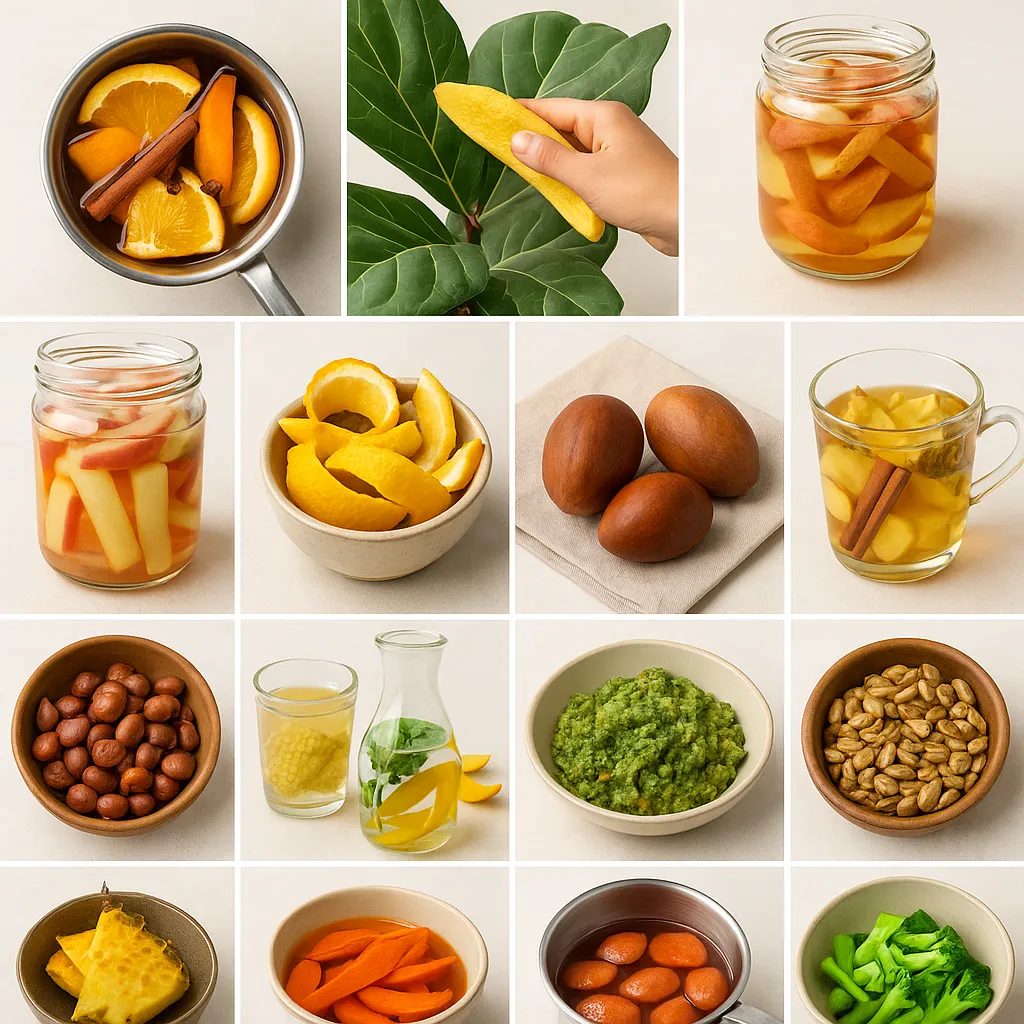Most of us don’t think twice before tossing fruit and veggie scraps into the trash or compost bin. But hidden in those peels, pits, and stems are dozens of clever ways to save money, reduce waste, and add a touch of creativity to your kitchen routine. From transforming citrus peels into homemade cleaners to turning avocado pits into natural dye, these zero-waste kitchen hacks prove that every bit of your produce has value. Not only do they help the planet by cutting down on food waste, but they also make everyday cooking, cleaning, and self-care more resourceful and fun.
1. Orange & Lemon Peels as Natural Air Fresheners
Instead of tossing out your citrus peels, try simmering them in a small pot of water with a few cinnamon sticks or cloves. Within minutes, your kitchen will be filled with a warm, citrusy fragrance that feels both refreshing and comforting. I’ve done this many times after cooking fish or frying food, and it works wonders at neutralizing stubborn odors without relying on chemical sprays. If you want to get creative, you can even add a splash of vanilla or a sprig of rosemary for a more unique scent blend that feels almost like a boutique candle.
2. Banana Peels for Shiny Houseplants
If you’ve got houseplants that are looking a bit dull, you don’t need expensive leaf polish. Simply take the inside of a banana peel and gently wipe it across the leaves. Not only does it remove dust, but it also leaves a subtle shine and gives your plants a tiny nutrient boost. I started doing this after a friend showed me her thriving fiddle-leaf fig, and I was surprised at how much fresher my plants looked afterward. It’s a quick, natural fix that makes your greenery look vibrant and well cared for.
3. Apple Peels for DIY Vinegar
Apple peels can easily be turned into homemade apple cider vinegar with just sugar and water. All you need to do is let them ferment in a jar for a few weeks, stirring occasionally, and you’ll have a multipurpose vinegar that works for cooking, cleaning, or even beauty recipes like hair rinses. I once made a small batch after a big apple pie baking day, and it turned out so well that I didn’t buy store-bought vinegar for months. It’s one of those hacks that feels incredibly rewarding because you’re turning what would be waste into something truly useful.
4. Watermelon Rinds for Pickles
Don’t throw away watermelon rinds after enjoying the sweet flesh. With a little vinegar, sugar, and spices, you can pickle them into a crunchy snack that tastes surprisingly refreshing. I first tried watermelon rind pickles at a farmer’s market, and I was amazed at how tangy and crisp they were. Making them at home became a fun summer ritual, and it’s a great way to impress guests when they see you’ve found a use for something most people discard. Plus, it adds a unique, sustainable twist to your table spread.
5. Pineapple Skins for Tea
Those spiky pineapple peels have more flavor than you’d expect. By boiling them with ginger and a bit of cinnamon, you can create a soothing tropical tea that also gives your immune system a little boost. I like to make a batch in the evening, let it chill overnight, and enjoy it cold the next day as a refreshing iced tea. It always surprises people when I mention it’s made from pineapple skins, and it’s a great reminder that so much goodness is hiding in the parts we usually toss away.
6. Citrus Zest for Homemade Seasoning
One of the simplest ways to extend the life of your citrus scraps is by turning the peels into homemade zest powder. Just dry lemon, lime, or orange peels in the oven at a low temperature until crisp, then grind them into a fine powder. This seasoning adds a bright, tangy kick to marinades, baked goods, and salad dressings. I often sprinkle a little over roasted vegetables or grilled chicken, and it completely elevates the flavor. It’s like keeping a jar of sunshine in your pantry, ready to bring any dish to life.
7. Avocado Pits for Dye
Avocado pits may seem useless, but they hold a hidden secret: they produce a gorgeous pinkish dye. By boiling the pits in water for an hour or two, you can create a natural colorant perfect for fabrics, yarn, or even paper crafts. The first time I tried this, I couldn’t believe that such a soft, rosy shade came from something I normally tossed away. It’s a fun and eco-friendly project that adds a creative touch to household textiles, and it’s especially rewarding if you enjoy DIY crafts.
8. Grape Skins for Natural Food Coloring
If you’ve ever peeled grapes for a recipe, don’t discard those vibrant skins. By simmering them in water, you can extract a deep purple-blue liquid that works wonderfully as natural food coloring. I once used it to tint homemade frosting for a birthday cake, and not only did it look stunning, but guests loved knowing it was colored naturally. It’s a simple way to cut down on artificial additives while giving your baked goods and candies a unique, organic flair.
9. Pomegranate Peels for Skincare
Pomegranate peels are loaded with antioxidants, making them excellent for homemade skincare. Dry the peels, grind them into a fine powder, and mix with honey or yogurt to create a natural exfoliating mask. I tried this during a weekend self-care routine, and the mask left my skin feeling soft and refreshed with a subtle glow. It’s an inexpensive way to treat your skin with nutrients while reducing waste from one of the healthiest fruits around.
10. Citrus Peels for All-Purpose Cleaner
With just citrus peels and vinegar, you can create a powerful, eco-friendly cleaner that smells amazing. Fill a jar with orange or lemon peels, cover them with white vinegar, and let it sit for two weeks before straining. The result is a natural cleaner that works on counters, sinks, and even windows. I use this in my kitchen regularly, and it’s reassuring to know that I’m keeping my home clean without harsh chemicals. Plus, the fresh citrus scent lingers long after cleaning, making the whole space feel brighter and fresher.
11. Cherry Pits for Homemade Heat Packs
Instead of tossing cherry pits after enjoying the fruit, wash and dry them thoroughly, then sew them into a small cloth pouch. When microwaved for a couple of minutes, they turn into a reusable heat pack that stays warm for a surprisingly long time. I made one during cherry season, and it’s become my go-to remedy for sore shoulders or chilly winter nights. It feels amazing to repurpose something so small into a practical comfort item.
12. Corn Cobs for Broth
After you’ve cut off the kernels, don’t throw away the bare cob. Simmering corn cobs in water with herbs and garlic creates a subtly sweet broth that’s perfect for soups or risottos. I stumbled upon this trick after a summer barbecue, and the resulting broth made my vegetable soup taste incredibly rich. It’s a wonderful way to capture every last bit of sweetness from fresh corn.
13. Mango Peels for Infused Water
Mango peels still hold plenty of tropical flavor. Drop a few into a pitcher of water with mint and let it infuse for a refreshing, lightly sweet drink. I tried this once while prepping mangos for smoothies, and it became a summer favorite—especially when served chilled with ice cubes. It’s a simple trick that turns plain water into something you actually crave.
14. Carrot Tops for Pesto
Many people throw away carrot greens, but they’re packed with nutrients and have a flavor similar to parsley. Blend them with garlic, olive oil, nuts, and parmesan to create a unique pesto. I once swapped them in for basil when I ran out, and the result was so good I now make carrot-top pesto on purpose. It pairs beautifully with pasta, sandwiches, or even roasted veggies.
15. Potato Peels for Crispy Snacks
Those thin potato skins you peel off can be baked or air-fried into crunchy chips. Toss them with olive oil, salt, and spices, then roast until crisp. I remember making a batch after peeling potatoes for mashed potatoes, and everyone at the table ended up fighting over the “peel chips.” They’re proof that even scraps can be turned into irresistible snacks.
16. Strawberry Tops for Smoothies
Strawberry leaves and tops are often discarded, but they’re edible and add extra nutrients when blended. Just toss them into smoothies along with the fruit for a zero-waste boost. I’ve been doing this for years, and honestly, you don’t even taste the difference—but you get that added fiber and reduce food waste at the same time. It’s one of the easiest hacks to adopt because it requires no extra effort.
17. Onion Skins for Natural Dye
Onion skins may seem like nothing more than papery waste, but they create a gorgeous golden-brown natural dye when simmered in water. I once used them to color Easter eggs, and the result was a rustic, earthy tone that looked far more unique than anything store-bought. This trick also works on fabrics, giving them a warm, natural hue with zero chemicals involved.
18. Celery Leaves for Soup Garnish
Most people toss celery leaves, but they’re actually loaded with flavor and nutrients. Chop them finely and use as a garnish for soups, salads, or even pasta dishes. I started saving them after realizing they had the same bright, fresh taste as parsley, and now I can’t imagine wasting them. It’s a small change that adds a professional finishing touch to everyday meals.
19. Cucumber Peels for Refreshing Water
Cucumber peels can be added directly to water for a spa-like infusion. The flavor is crisp and cooling, making plain water feel like a treat. I first tried this at a hotel that offered cucumber-infused water in the lobby, and now I make it at home whenever I have extra peels. It’s a great way to stay hydrated while enjoying a little luxury in your daily routine.
20. Pumpkin Seeds from Jack-o’-Lanterns
When carving pumpkins, most people scoop out the seeds and throw them away. Instead, rinse, season, and roast them for a crunchy, protein-packed snack. I’ve been doing this every fall since childhood, and the smell of roasting pumpkin seeds is now one of my favorite autumn traditions. They’re addictive, healthy, and a perfect reminder of how seasonal scraps can become delicious.
21. Peach Pits for Infused Syrup
Peach pits still carry plenty of flavor. Simmer them in sugar and water to make a subtly fruity syrup that’s perfect for cocktails, iced tea, or desserts. The first time I tried this, I poured the syrup over pancakes, and it instantly became a family favorite. It’s a clever way to stretch the flavor of summer peaches just a little bit further.
22. Broccoli Stems for Stir-Fries
While many discard broccoli stems, they’re actually tender and delicious once peeled and sliced thin. Toss them into stir-fries or sauté them with garlic for a quick side dish. I discovered this when I challenged myself to use every part of my groceries, and I was surprised at how sweet and crunchy the stems were. It feels like unlocking a hidden vegetable that was there all along.
Living a more sustainable lifestyle doesn’t have to mean making huge sacrifices—it often starts with simple shifts like reusing what you already have. These zero-waste kitchen hacks show how fruit and veggie scraps can be repurposed into something practical, flavorful, or even beautiful. Whether it’s brewing pineapple peel tea, making natural skincare from pomegranate peels, or roasting up crunchy potato skins, every small change adds up. The best part? You’ll save money, discover new flavors, and feel good knowing you’re giving your food a second life instead of letting it go to waste.


